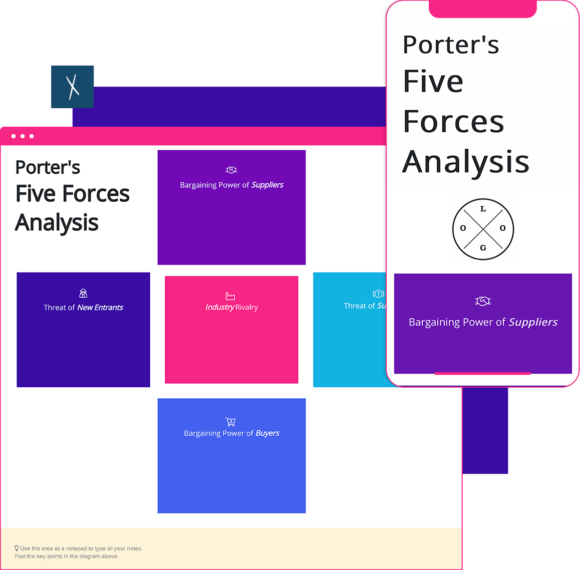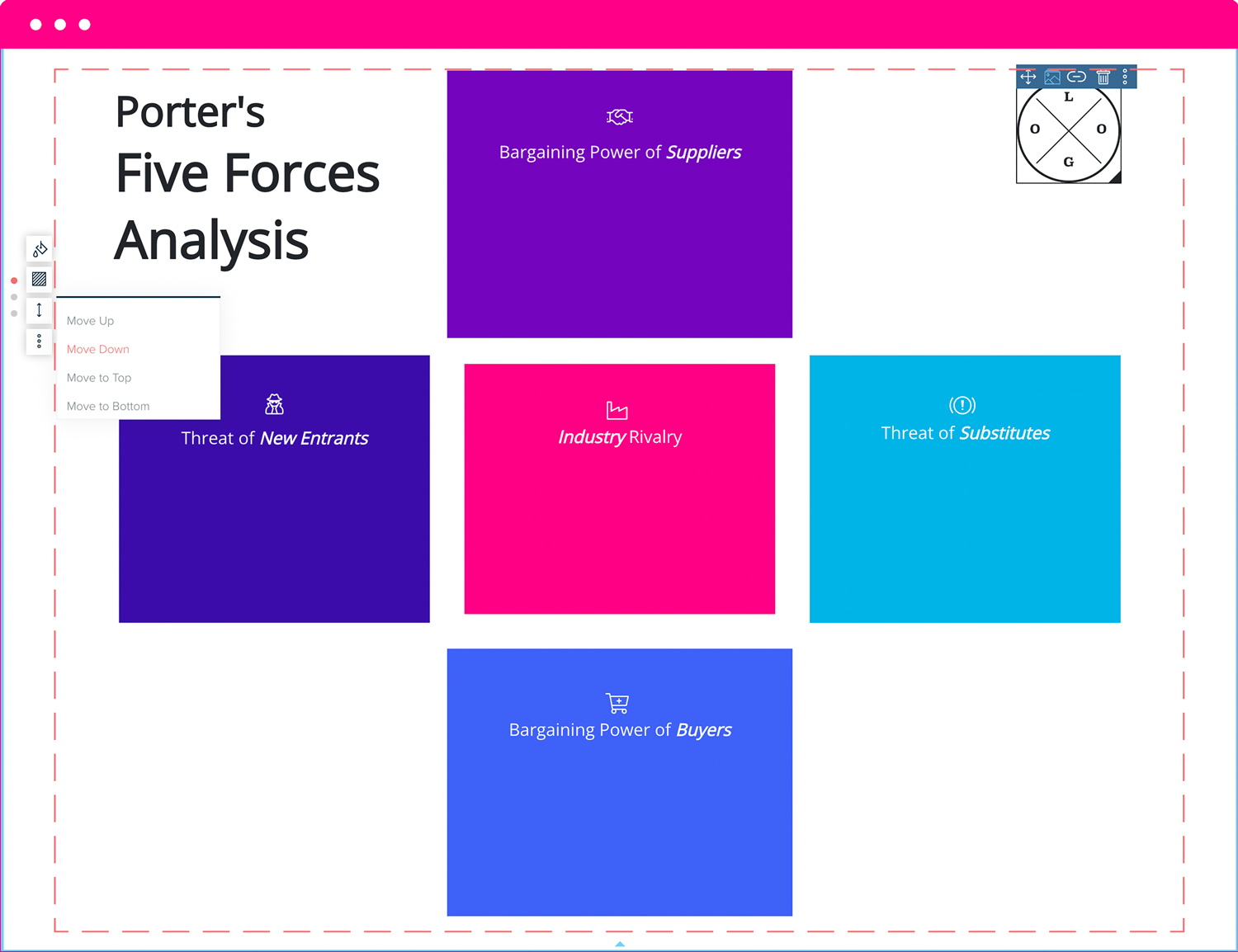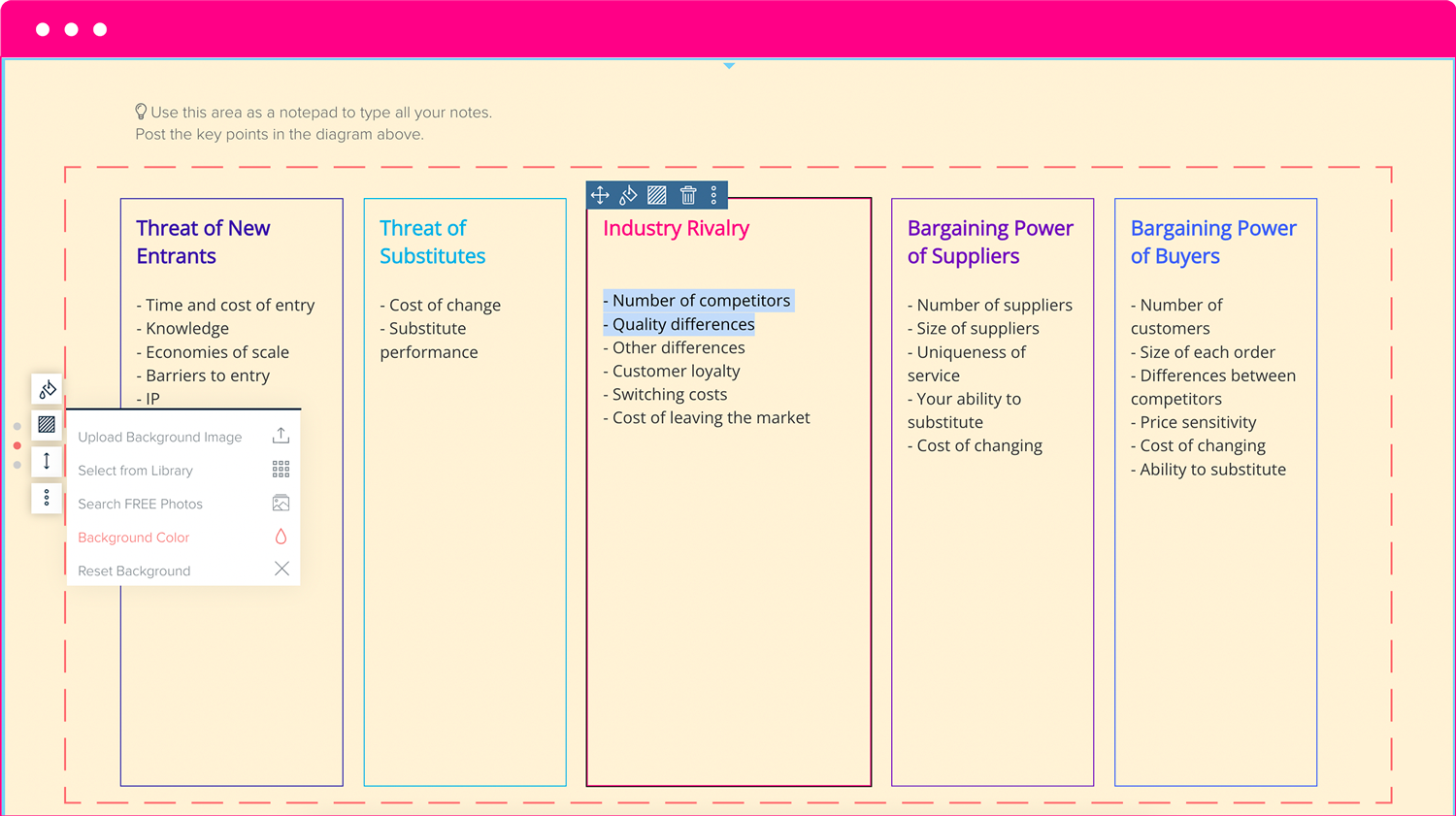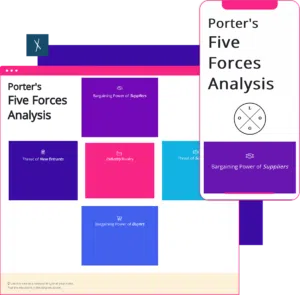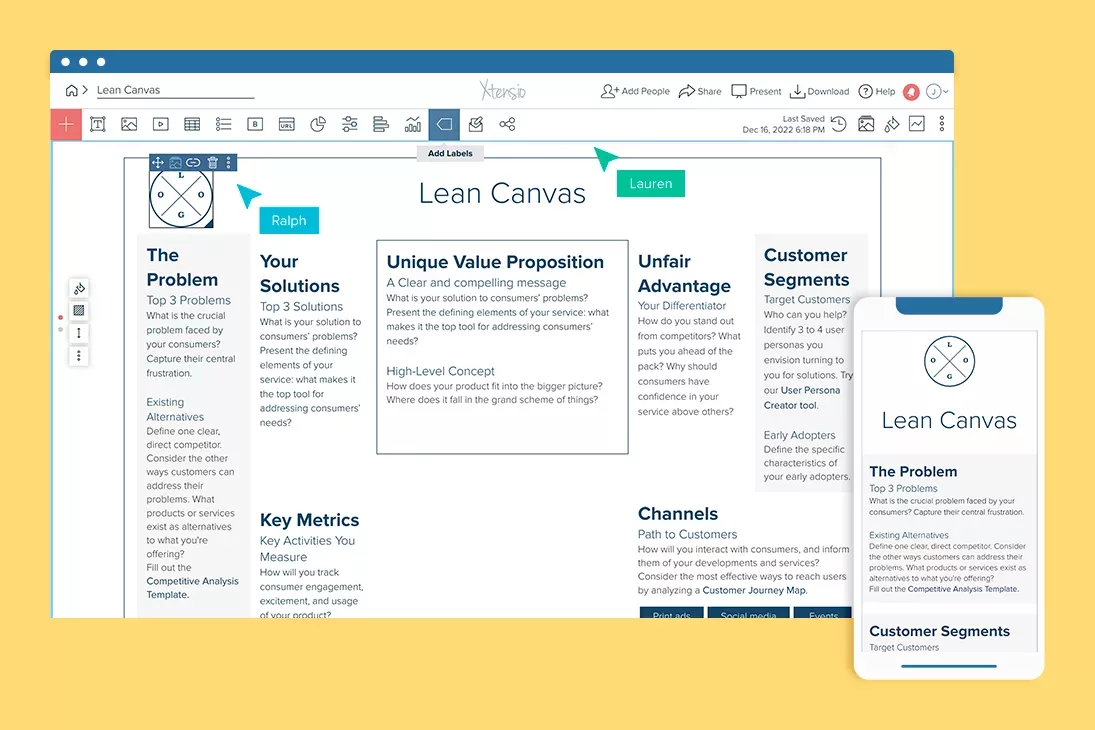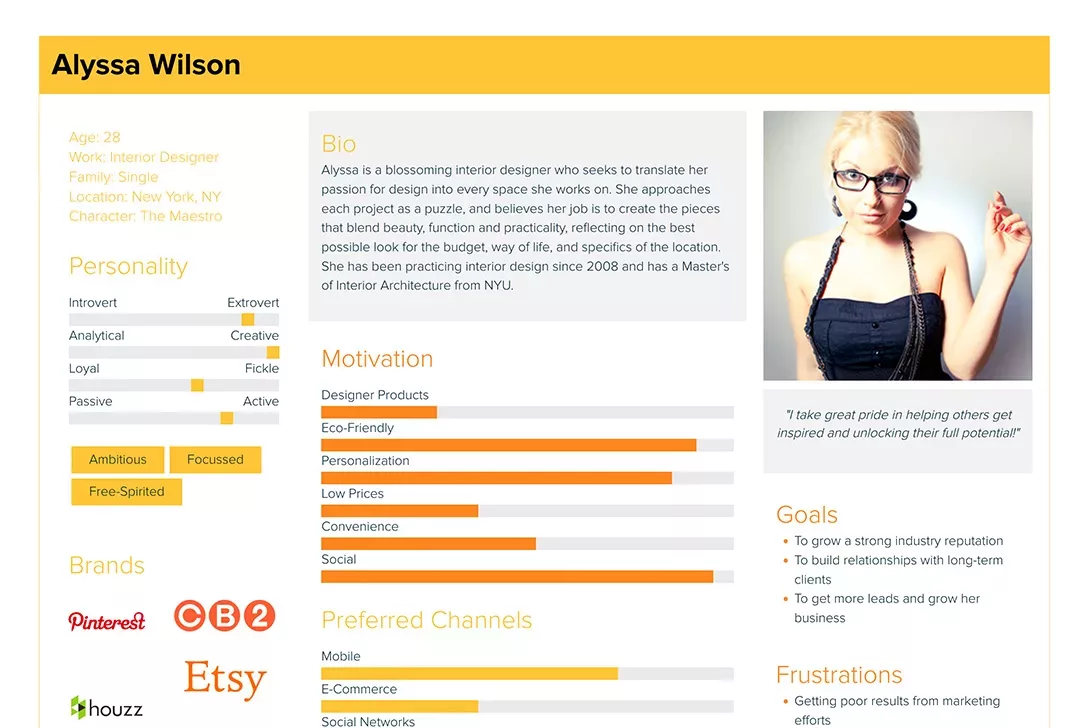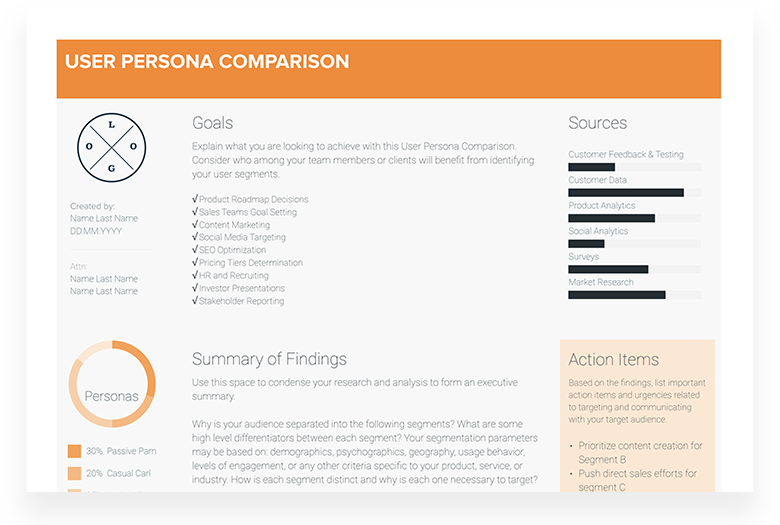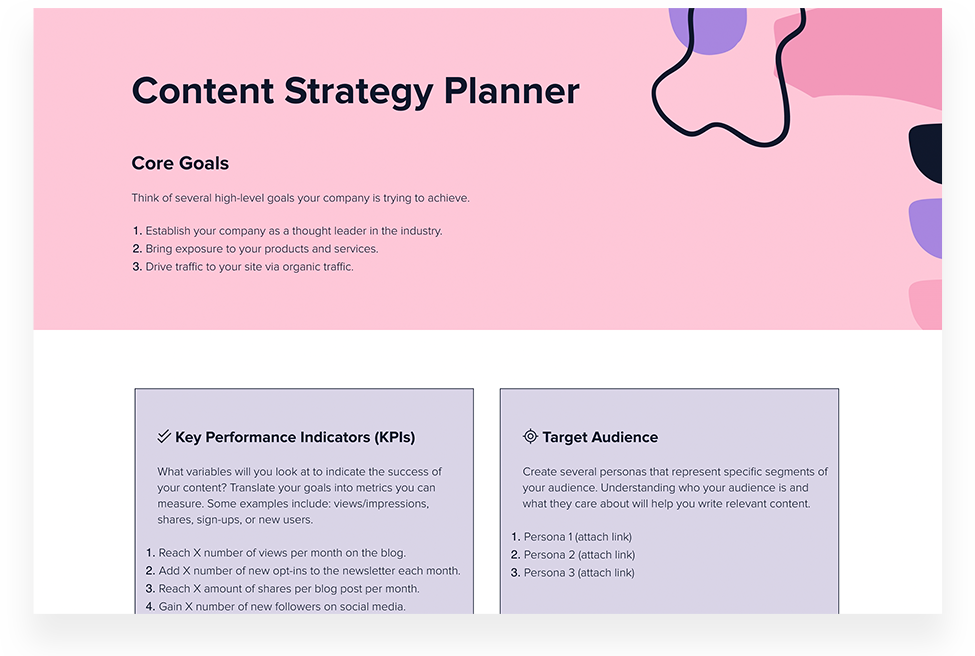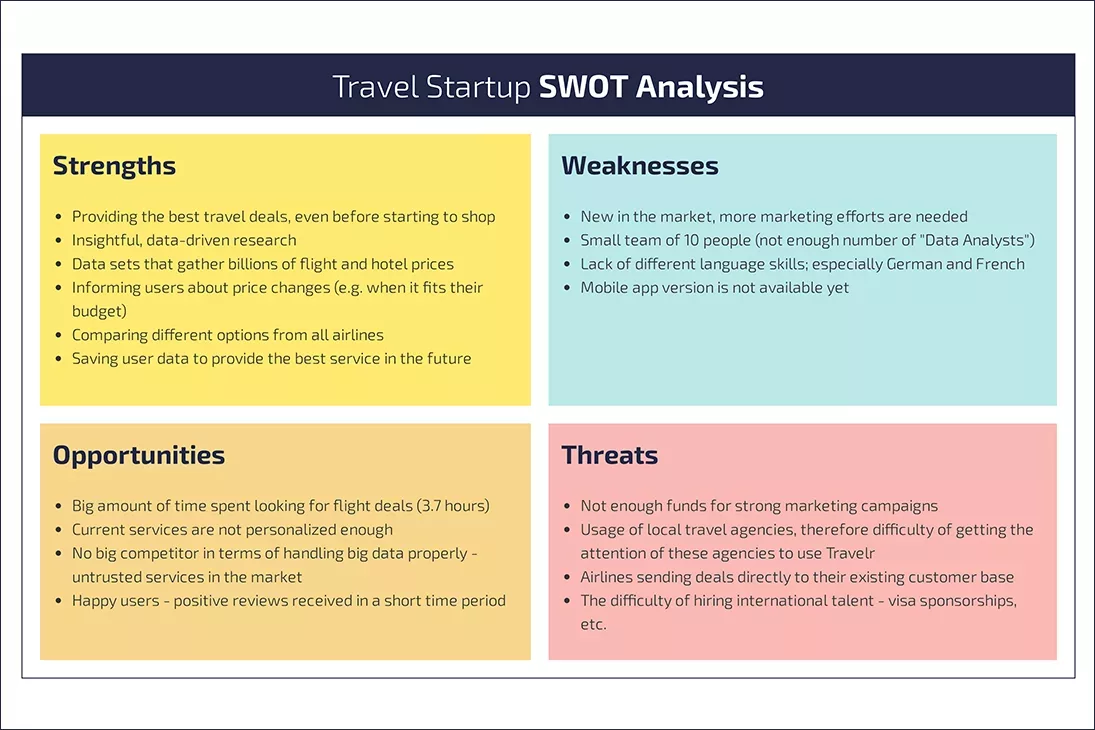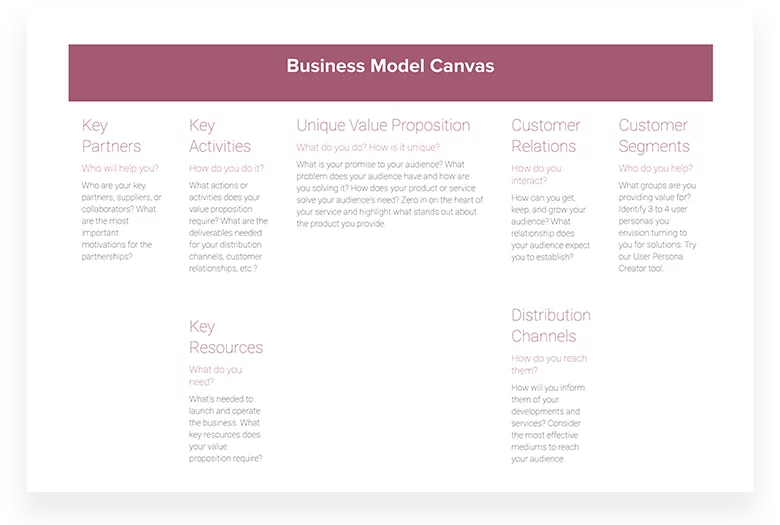Porter Analysis Template
Porter’s Five Forces Analysis is a strategic framework to analyze five forces that shape a competitive landscape. Threats from substitute products or services, the threat of new entrants, the state of industry rivalry, and the bargaining power of suppliers and customers.
Use Xtensio’s guiding template for Porter’s Five Forces Analysis to:
- Assess the intensity of the competition in your market.
- Identify key competitors.
- Inform your business and marketing strategy.
Click and start editing. Create an account if you like it.
Beautiful living documents, built like web pages.
Join 246,768 professionals using Xtensio.
Beautiful living documents, built like web pages.
Join 246,768 professionals using Xtensio.
Porter’s Five Forces Analysis is a strategic framework to analyze five forces that shape a competitive landscape. Threats from substitute products or services, the threat of new entrants, the state of industry rivalry, and the bargaining power of suppliers and customers.
Use Xtensio’s guiding template for Porter’s Five Forces Analysis to:
- Assess the intensity of the competition in your market.
- Identify key competitors.
- Inform your business and marketing strategy.
Click and start editing. Create an account if you like it.
Pros and Cons of the Five Forces Analysis
The Five Forces model was introduced by Harvard’s Michael E. Porter, as an alternative to the SWOT analysis and was first published in Harvard Business Review in 1979.
The five forces are horizontal:
- Threats from substitute products or services
- The threat of new entrants
- The state of industry rivalry
and vertical:
- The bargaining power of suppliers
- The bargaining power of buyers or customers
The objective of the Five Forces Analysis is to assess whether a product or service can adequately enter and excel in the market. If the forces are too strong, the conditions may be unattractive for profitability. A market that is optimal to enter is one where competition can coexist and reasonable profit margins are achievable for new players. The Five Forces is a great way to assess these forces.
Five Forces Analysis has been critiqued for the broad perspective it takes, excluding the specifics of an industry, and the relational forces between industries, or industry clusters. This analysis also does not focus on the actions or opportunities that can be taken in the face of these macro-level forces. Later in the 90s, a 6th force named “complementors” has been introduced by Yale academics Nalebuff and Brandenburger. This addition to the five forces addresses the possibility of strategic alliances, which is relevant for today’s complex landscape interconnected with tech-driven businesses.
How to use Porter’s Five Forces Analysis Template?
Click on Xtensio’s Five Forces Analysis Template and you will see two sections.
The bottom section comes with instructional text to help you research and address the dynamics of each of the five forces. You can use this part as a worksheet to populate with all your findings.

XTENSIO TIP: Click and add text without worrying about the length or fitting all your findings on a single page. Xtensio pages are infinitely scrollable like web pages, so don’t be afraid of formatting or design as you brainstorm.
The top section is a more visual section where you can post the summary of your findings, the most vital points that you can view and share with others. This part then becomes a good piece to include in presentations, and among other strategy and planning documents to present to stakeholders and discuss.

XTENSIO TIP: You can click the three dots to the left and copy this work to other projects.
The Five Forces Analysis is one of the alternatives to the popular SWOT analysis (Learn how to do a SWOT analysis here). It is most effectively used by marketing strategists or business consultants when accompanied by other strategic frameworks and models like the value chain analysis, or Competitive Analysis. It is important to make use of analytical exercises like the Five Forces Analysis to obtain a broad perspective of the industry and general marketplace your organization is striving to exist in. That said, the fragility of global economic, social, and political systems calls for an adaptive mindset, and a creative ability to fill in the gaps left by traditional business frameworks.
See how Xtensio can help your business

Build and launch products and services successfully.

Engage buyers more and close sales faster.
Used by the world’s top businesses.
246,768 users and counting.



Jerome Katz
Professor of Entrepreneurship @

Jake Peters
CEO @

Robin Bramman
Founder and Chief Brand Mixologist @

Alix Han
VP Product Experience @

Marc Anthony Rosa
Product Manager @

Anna Yunker
Content Strategist @

Robin Eyre
Owner @

Adam Sher
CEO @

Humma Arshad
Salesforce Project Manager @
Frequently asked questions
What is Xtensio?
Xtensio is the quickest and easiest way for teams to create, share and manage all of their business documents together. Create pitches, sales sheets, reports, case studies, agendas and more. Add images, videos, tables, buttons and other interactive modules. Drag and drop, resize, change backgrounds, colors. Share a link. Present a digital slideshow. Export a PDF/PNG.
Do I need to download software?
Nope. Xtensio is a web browser-based platform.
What browsers are compatible with Xtensio?
Xtensio works on recent versions of all major browsers. The smoothest experience is on Chrome.
How is Xtensio different from PPT, Illustrator or Word?
Unlike other presentation or document creators, Xtensio works like a web builder so you can easily drag and drop interactive content, customize the layout, and change colors, fonts, backgrounds to get professional-looking business content out the door quickly, without needing a designer.
You can collaborate with team members and guests to work together in real-time on the cloud. And the flexibility to share projects as live web links, digital slideshow presentations or exportable PDF/PNGs means you don’t have to jump between tools when creating different deliverables. Check out this page to see how Xtensio outpaces the competition.
What is an Xtensio folio?
An Xtensio folio is a living document. It’s a live webpage, a full-screen digital slideshow presentation and an exportable PDF/PNG document all-in-one. Folios are responsive, collaborative and completely customizable.
Start from an instructional templates or a blank folio to build all your business documents and presentations with the ease of a web builder. Add team members and guests to work together in real-time on the cloud. Changes instantly sync to the live version of the folio so both internal and external stakeholders are always up-to-date. Xtensio folios are the next generation of flexible documents and presentations.
Is my data private and secure?
Yes. All Xtensio plans include 128 bit SSL encryption and backups to ensure your data is secure. Here’s more on the range of sharing options on Xtensio, from completely private to public.
Can I create a Porter’s Five Forces Analysis for free?
Yes. Any Xtensio template is FREE TO TRY. No need to add your credit card information to start editing. Create an account if you would like to save and share your work.
What would I get by upgrading to a premium plan?
By upgrading to a premium plan, you can claim your branded URL, unlock unlimited projects, and access additional team features to create and collaborate on documents and presentations. Here’s more about our premium plans.
What are alternative strategic frameworks to Porter’s Five Forces Analysis?
– SWOT Analysis
– PESTLE Analysis
– TOWS Matrix
– SOAR Analysis Template
– NOISE Analysis
To learn more about these strategic tools check out our Alternatives to SWOT Analysis page.
Can I invite colleagues to work on Porter’s Five Forces Analysis?
Yes! You can invite team members to your document. Work on it together, remotely. As a platform, Xtensio helps improve the way your team works. Here’s more on real-time collaboration .
How do I share my Five Forces Analysis?
When you’re ready to share your completed folio, choose between these options:
– Present it as a full-screen digital slideshow
– Send it as a responsive web link (you can even have the link show in slide view)
– Export it as a PDF or PNG.
Learn more about the different ways to share your projects in this tutorial video.
Can I modify Porter’s Five Forces Analysis Template?
Easily. Xtensio’s templates are fully customizable. You can use it as is simply by typing and editing the instructional text, and replacing images. If you’d like to go further apply any style you like. Change colors and fonts to match your branding. With drag and drop editor you can modify the layout, and repurpose the template for your specific needs.
Can I make my own templates on Xtensio?
Please do! Start with an existing template, modify it to your own needs and visual style, and save it as your team template. Start off new projects based on your own version. Submit a unique template design to us and we will promote it along with your profile!
